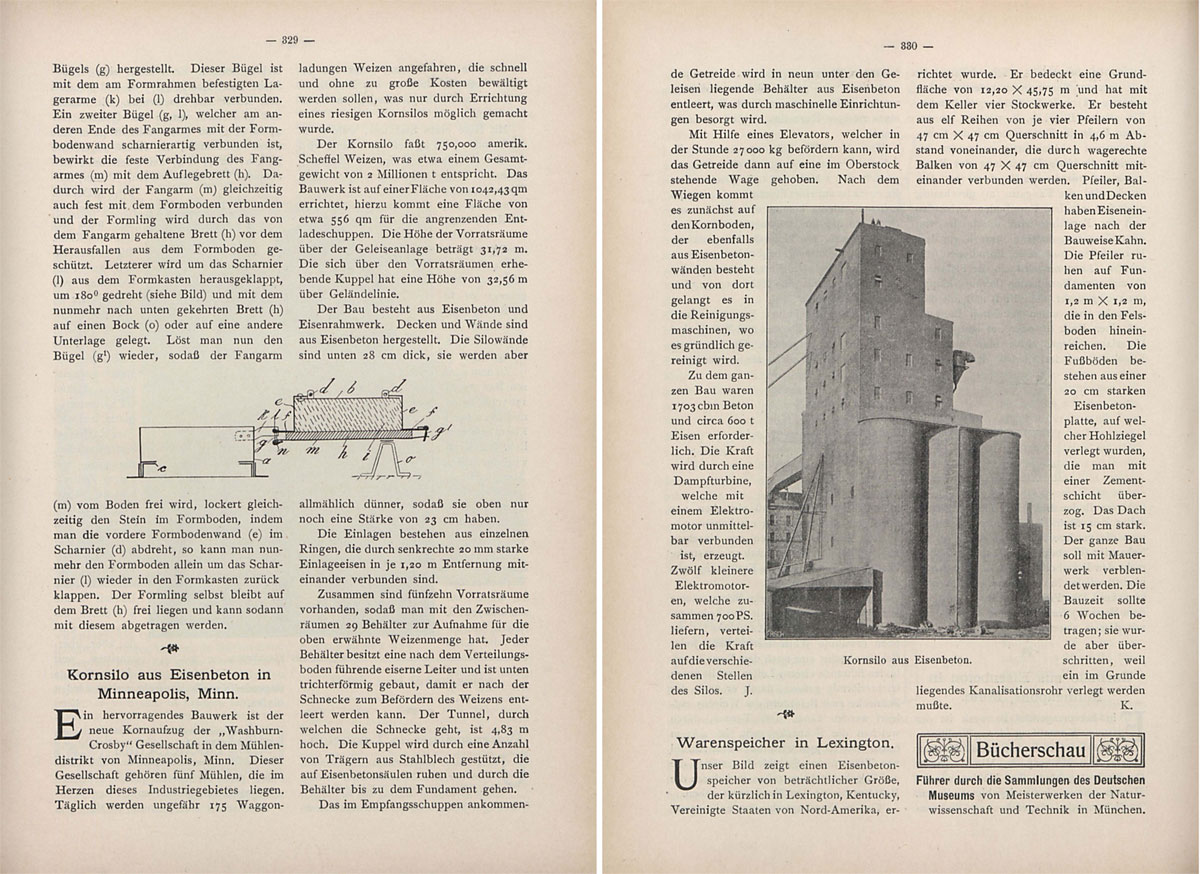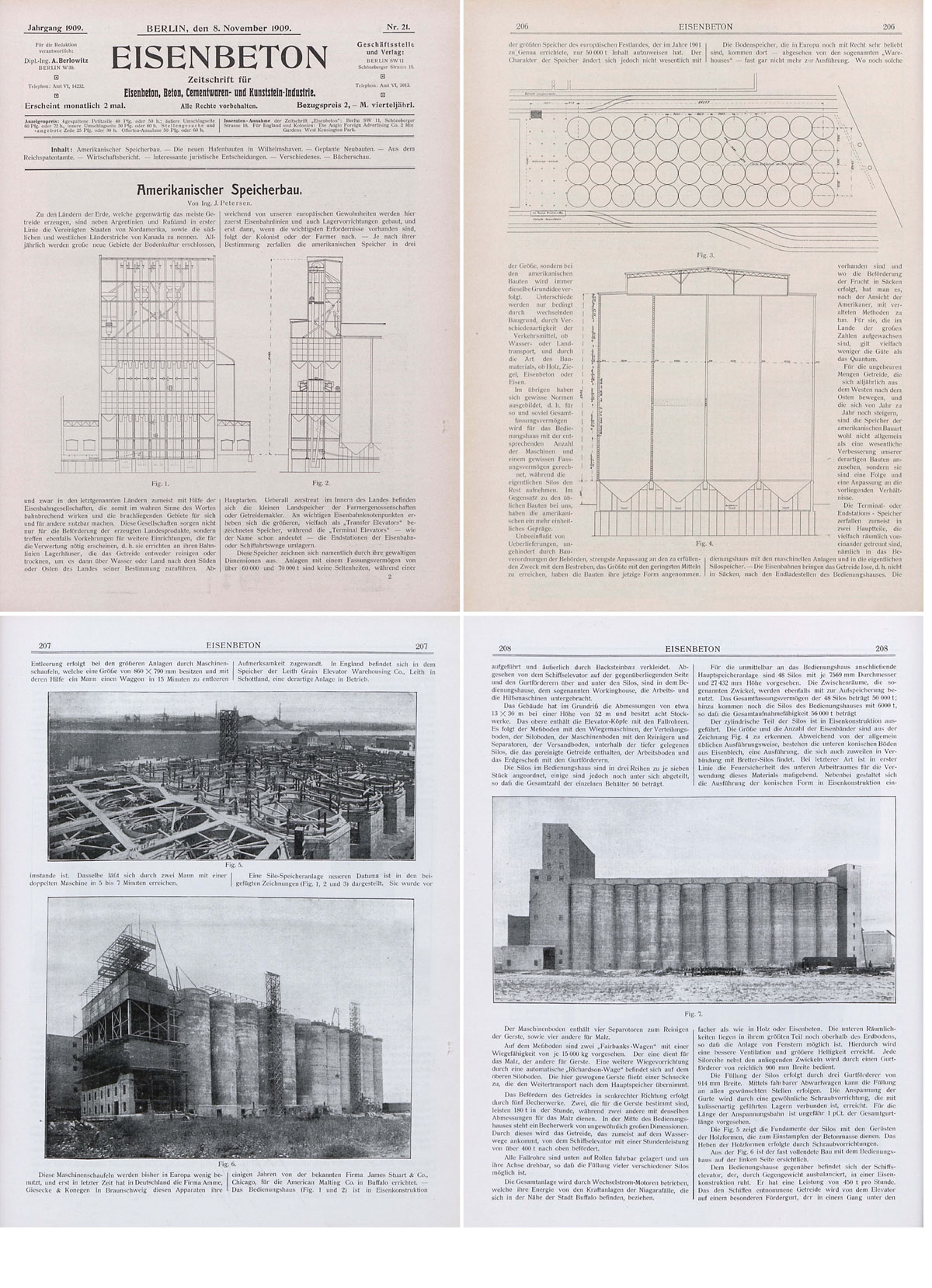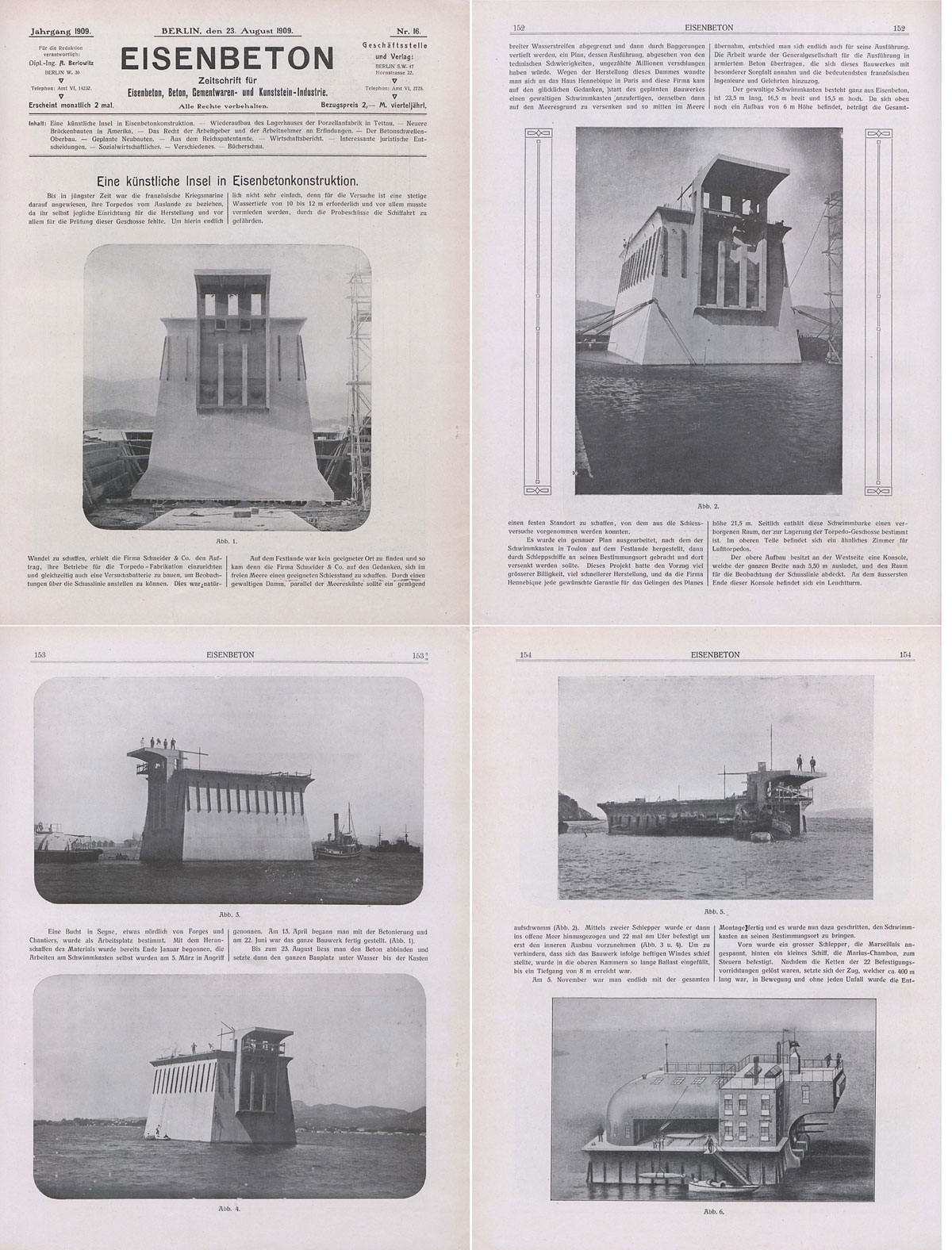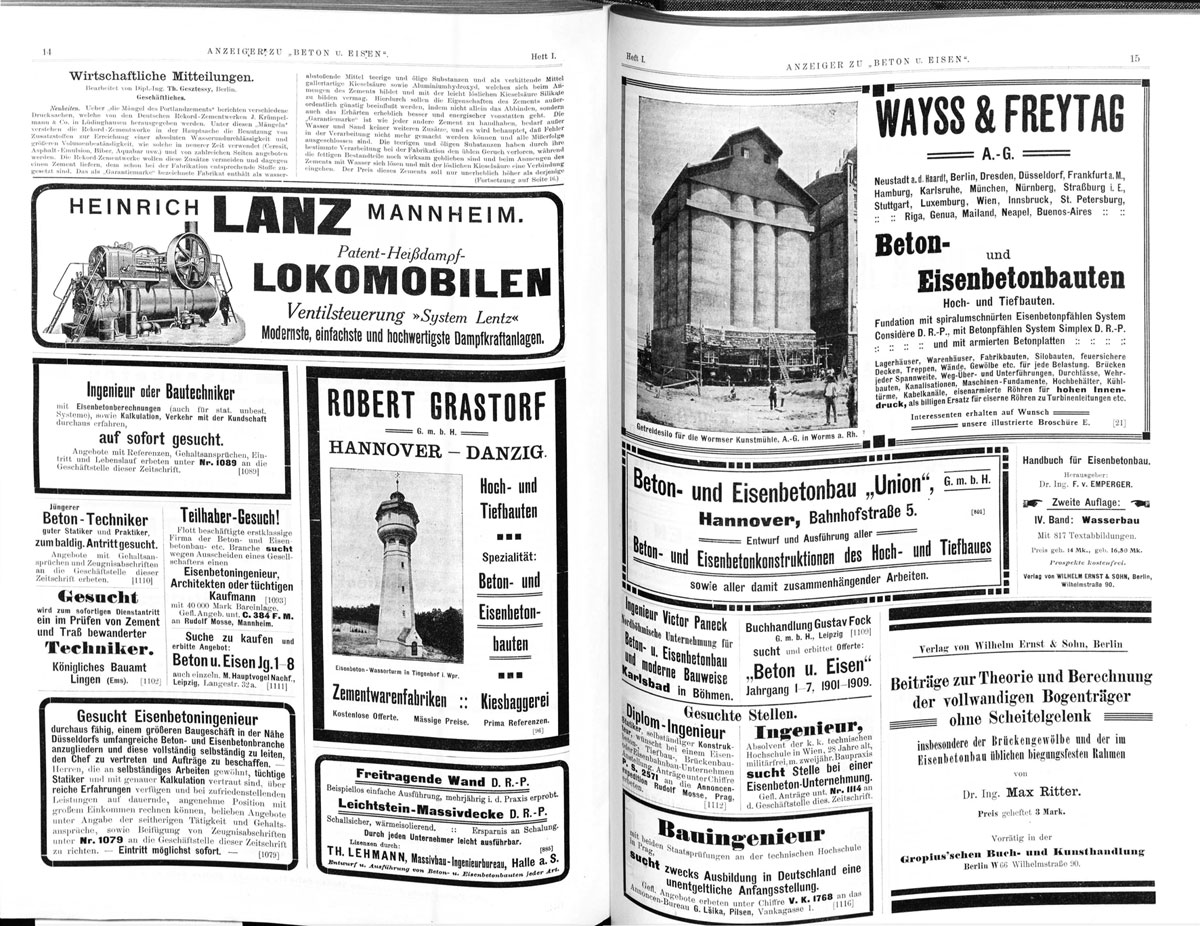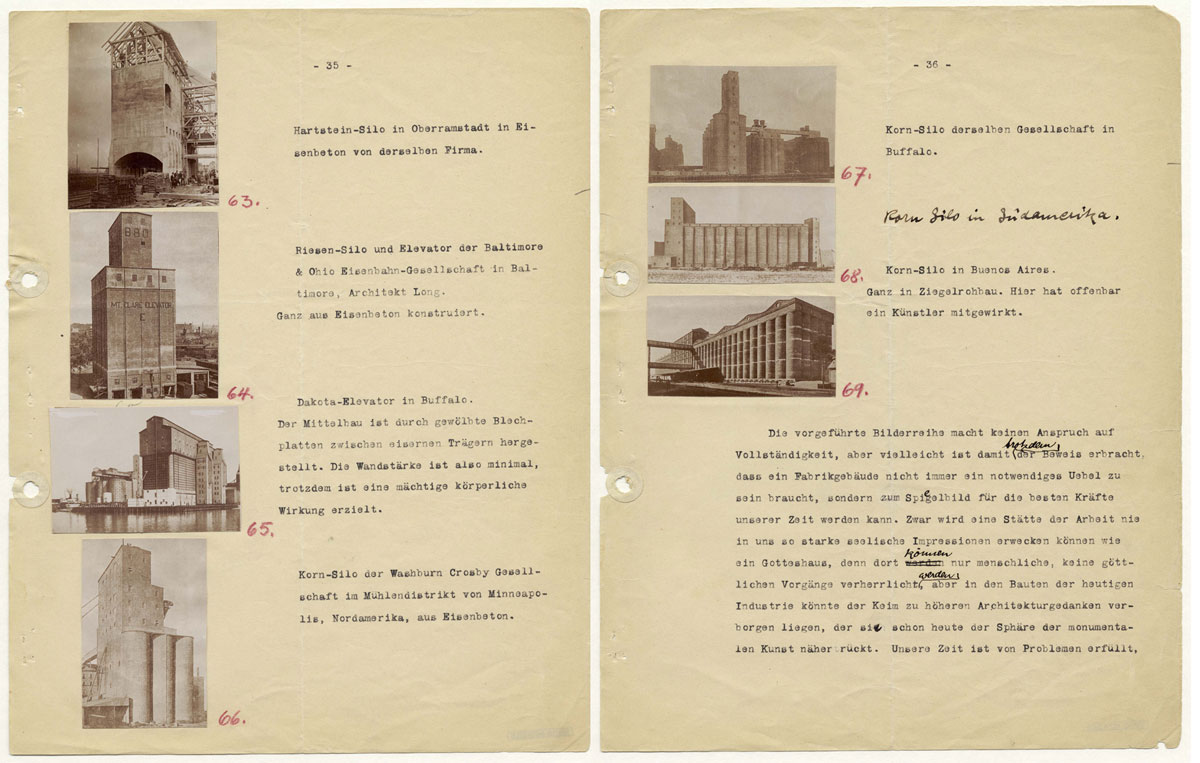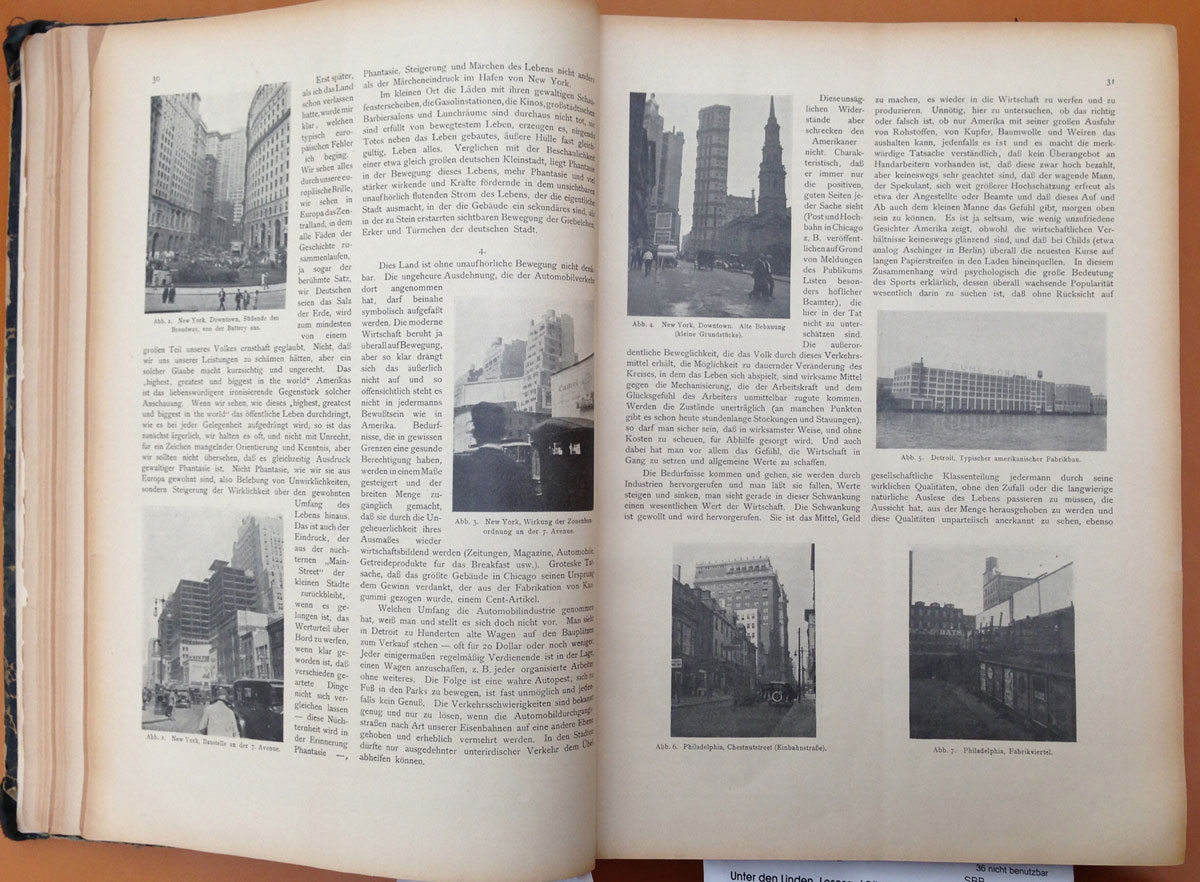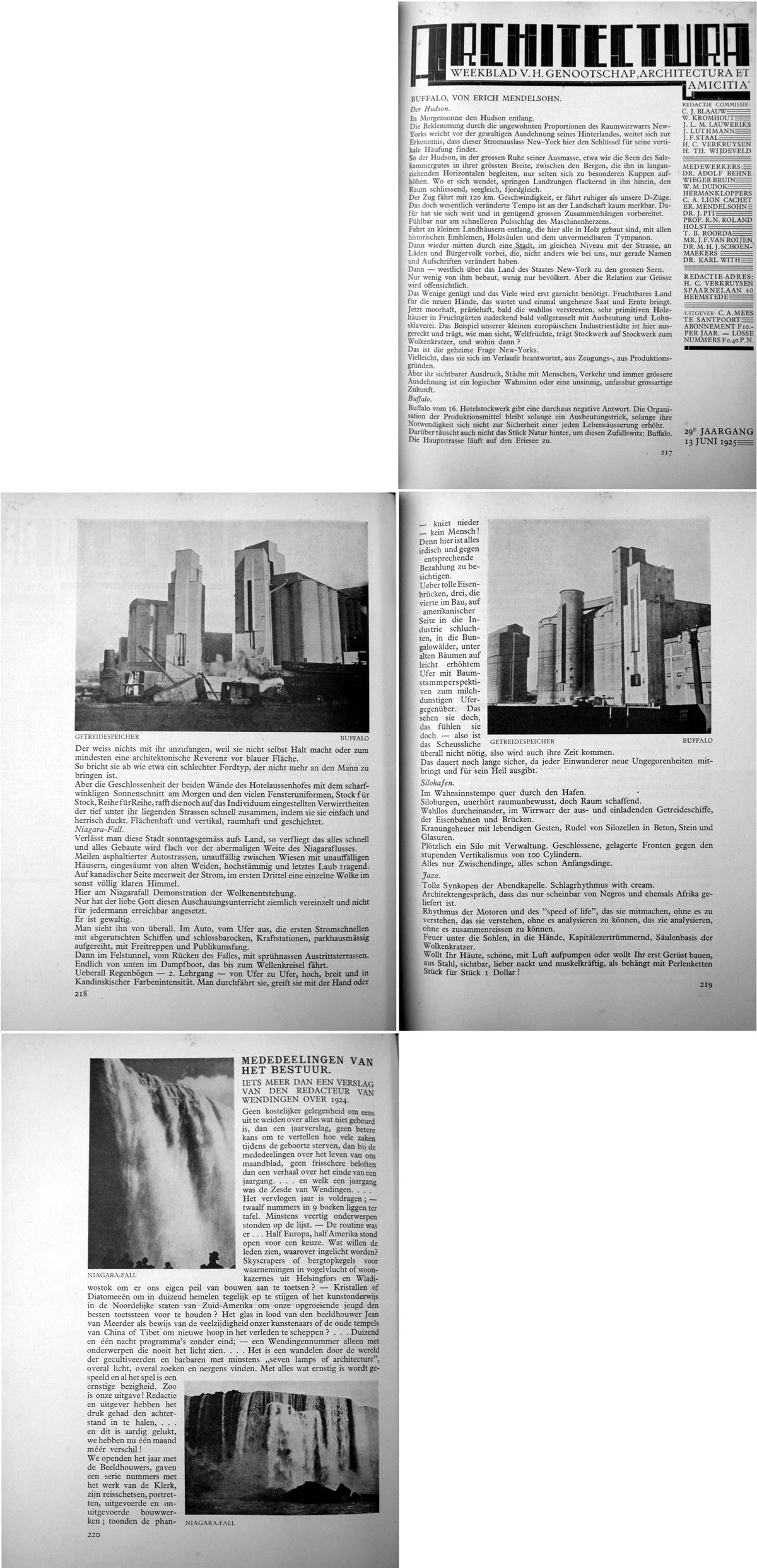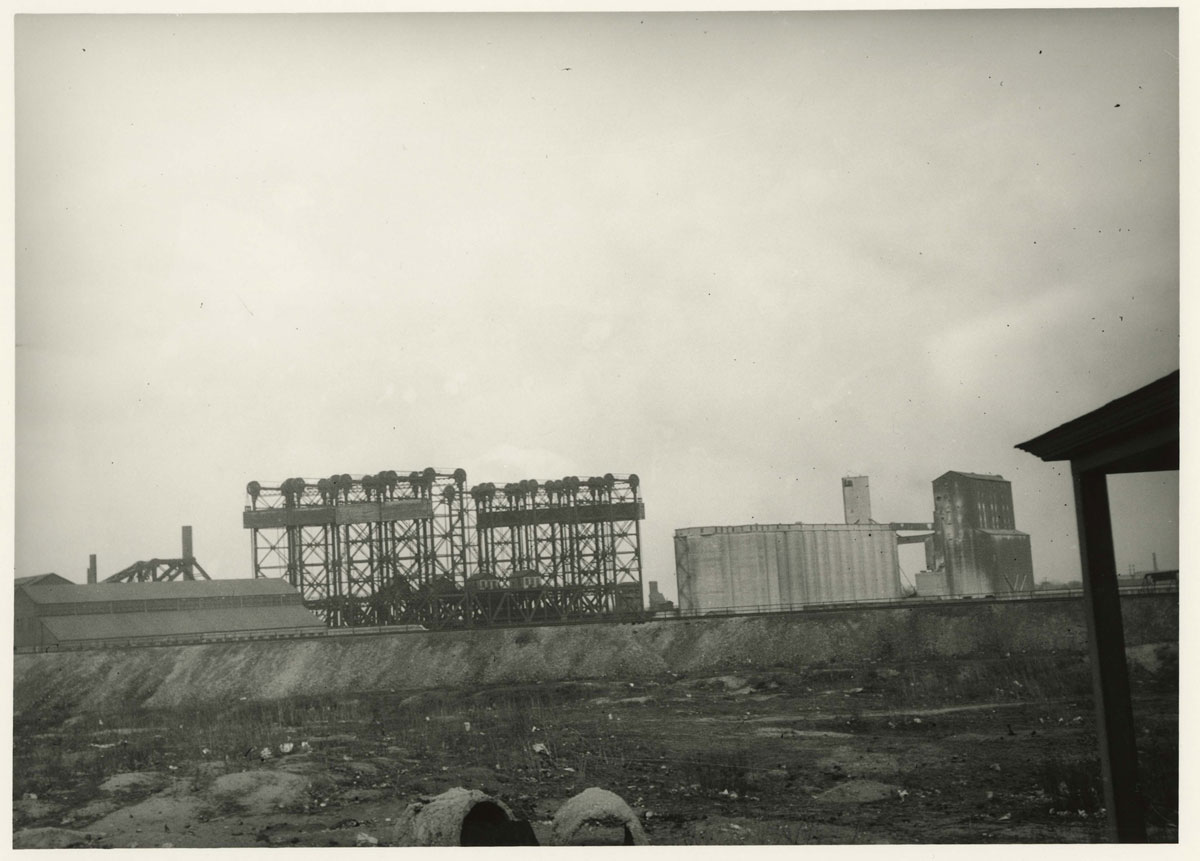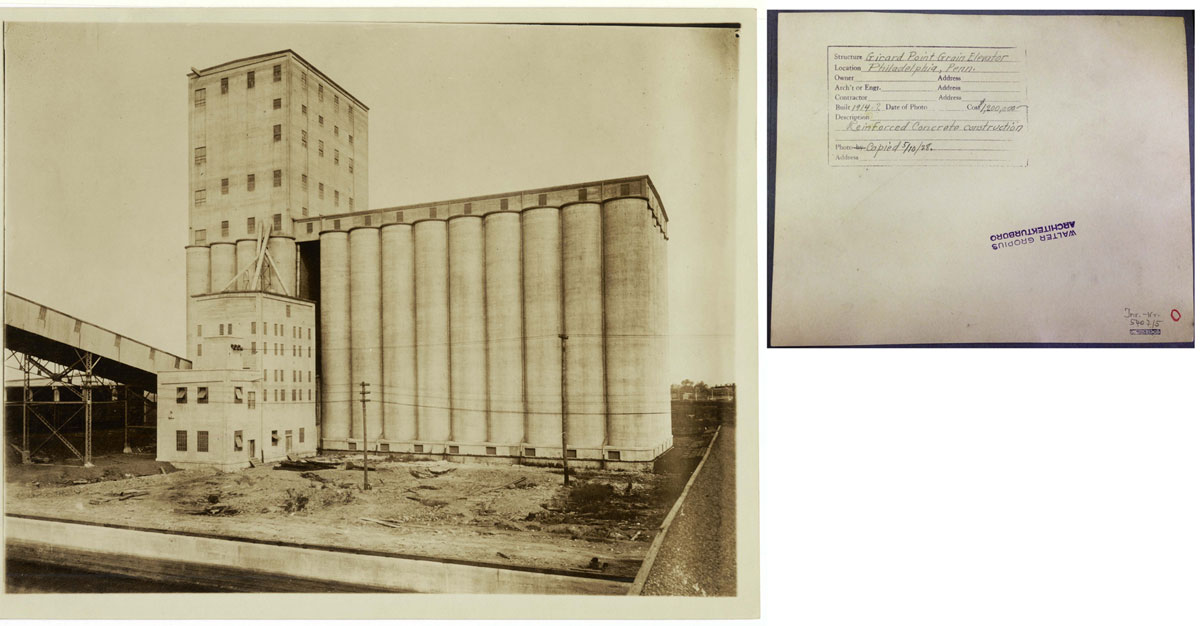Introduction
Anyone familiar with 20th-century Western architectural history will know of the grain elevators of North and South America made famous by Walter Gropius, Le Corbusier, Reyner Banham and others. They have appeared repeatedly in lectures, exhibitions and other media. That these buildings are now recognised as canonical is suprising, however, because they originated as a handful of photographs first selected by Gropius to illustrate his article ‘Die Entwicklung Moderner Industriebaukunst’ [‘The Development of Modern Industrial Architecture’] in the 1913 Jarhbuch des Deutschen Werkbundes, a Werkbund yearbook. Although the photographs of the elevators had been previously disseminated via public lectures and exhibitions, it was through their repeated reproduction, prompted by Gropius’s initial print dissemination, that this photographic canon emerged and spread (Mejía Moreno 2014). As is the case for other modern buildings, like Lilly Reich and Ludwig Mies van der Rohe’s German Pavilion for the International Exhibition in Barcelona (1929), we still encounter the elevators as mandatory reference points in modern architecture through their reproduction as photos in the early 20th century (Mejía Moreno 2020).
Even though the stability and durability of photographs has fascinated people since the inception of photography, it was only in the 1930s that these qualities became phenomena tied to their repeated reproduction. For Carl Einstein, a German writer and art historian, repetition ‘served a lie that humanity told itself about the Real; repetition generated the “illusion of the immorality of things,” and endowed them with a semblance of stability and durability’. ‘Images’, Einstein continued, ‘proved more secure and durable than human beings’ (Einstein and Haxthausen 2004: 159). The reproduction of the grain elevator photographs speaks to the importance of the images’ stability, which affected architectural culture; the repeated appearance of these photographs in print has established this photographic canon, perhaps uncritically. While the elevators have featured prominently in the history of construction and the use of ferro concrete within engineering contexts, as well as in the history of economics and production, in architectural history the emphasis remains limited to their exterior appearance (Mejía Moreno 2015). As British historian Reyner Banham has argued, this is why, since Gropius, the elevators have mostly been recognised and referred to as ‘silos’ (Banham 1986).
Though discussion of the grain elevators has been at the core of modern architectural histories (Banham 1986; Behne 1923; Behrendt 1927; Brown 1993; Cohen 1995; Ginzburg 1924; Gropius 1913; Breuer and Jaeggi 2008; Le Corbusier 1923; Taut 1929; Schwartz 2000; Steiner 2013) and the study of ‘canons’ and ‘canonical buildings’ is normal, nonetheless the study of ‘photographic canons’ as a phenomenon in itself has not received sufficient attention. This article posits that the set of grain elevator photographs is a photographic canon that operates silently, sedimenting the histories of the photographs and the grain elevators, altering the ways in which we understand these buildings, normalising them as a narrow set of visual architectural representations, and, more surprisingly, supporting very different interpretations of the buildings. The set of photographs studied here and labelled a photographic canon include those of the North American grain elevators, particularly the photographs identified as being taken in Buffalo and Montreal and two others whose location is simply given as North America and South America. This article explores the photographic canon as a phenomenon that, though recognised within art history discourses, remains in need of further study and acknowledgment as a distinct phenomenon within architectural history and culture.
By focusing on the moment when the photo reproductions of the grain elevators became canonical and on the mechanisms that such a construct implied, this article uncovers the mechanisms, technologies, temporalities and spatial configurations embedded in the construction and legitimisation of the photographic canon. Such a canon does not rely only on print dissemination only, unlike textual canons, and it emerges within architecture as a reduction of the wider photographic and historical fields to which the photographs originally belonged. Furthermore, this article demonstrates that the elevators are not modern architecture per se. It was through their commodification and repeated iterations in different media that the elevators, as anonymously engineered structures, entered the architectural canon.
Recognising the existence of a photographic canon within architecture encourages researchers to question whether and how canons marginalise. Revealing the canon’s contingency is therefore a first step in the identification of the problematic hegemony of canonical constructs.
The Photographic Canon in Architecture
The definition of the term ‘canon’ as a rule or standard already evokes modes of regulation and normativisation according to which works can be measured. The visual theorist Griselda Pollock provides a useful and comprehensive definition of canon formation. In her book Differencing the Canon (1999), Pollock delimits the problems of exclusion that such a construct entails while identifying mechanisms and strategies to disrupt it:
I define the canon as a discursive formation which constitutes the objects/texts it selects as the products of artistic mastery and, thereby, contributes to the legitimation of white masculinity’s exclusive identification with creativity and with Culture … Canonicity exists in many forms … Hierarchy becomes a natural order, and what appears to survive from the past because of its inherent significance determines the values of the present … It must always be understood as selective tradition: ‘an intentionally shaping version of a past and a pre-shaped present, which is then powerfully operative in the process of social and cultural definition and identification.’ Tradition cultivates its own inevitability by erasing the fact of its selectivity in regard to practices, meanings, gender, ‘races’ and classes. (Pollock 1999: 9–10; emphasis in original)
Since the 1970s, the issue of canons has been politicised and addressed by different disciplines, such as philosophy, cultural studies and the sciences, and by scholars such as Kenneth Clark and Dominick La Capra (Clark 1980; La Capra 1994). In the arts and literature, canonisation was famously challenged by feminists such as Linda Nochlin and Toni Morrison, who favoured an explosion of the canon to expose its repressive and discriminatory nature; some advocated abandoning the canon altogether. Canons came under scrutiny in architecture, too. In 1975, the critic and historian Reyner Banham commented that the ‘canonical list of who is, and who isn’t, a member of the modern movement’ established by his tutor Nikolaus Pevsner in 1936 has not been ‘seriously questioned, only extended a little’ (Banham 1975: 12).
Within recent and current architectural discourse, the ‘canon’ as an ideological construct is still a matter of interest, and it is defended, questioned and, sometimes, disregarded (Gürel and Anthony 2006; Nasr and Volait 2012; Saunders 2001). Questions of inclusion — and, therefore, of exclusion — of architects and works in historical narratives and architectural canons persist.
On the other hand, the relationship between architecture and photography has been addressed in many different ways. Some have commented that architecture has been a subject of photography since its inception (Ackerman 2001; Pare 1982). What has more often been discussed within architectural history is how photographs have fixed the experiences of buildings both for those who could experience the edifices directly and for those who would never be able to (Cohen 1988: 11). Within architecture, therefore, photography was gradually integrated as an architectural representation — often even standing in for buildings themselves — while at the same time it has also shaped the multiplicity and singularity of architectures that we recognise through visual means, thus participating in the canonisation of architectural works.
More recently, historians and critics have challenged the understanding of photography as being at the service of architecture and vice versa, addressing the criticality of the medium and bringing to the fore the multiple ways in which architecture and photography inform each other (Campbell 2020; Colomina 1994; Higgott and Wray 2013; Nilsen 2017; Zimmerman 2014). However, photographic canons, although present in art and photography discourses, await further exploration in architecture. Recent scholarly efforts have critically considered the relationship between photography and architecture, which the recognition that photographic canons shape architectural discourse has unveiled. As part of this trend, this article explores the contingent forces that reaffirm the photographic canon through both repetition and exclusion.
The North and South American Elevators’ First Printed Dissemination Platform
The photographs of the anonymous grain elevators in North and South America became the best-known images of the elevators after their appearance in Gropius’s article ‘Die Entwicklung Moderner Industriebaukunst’ (‘The Development of Modern Industrial Architecture’). They were published as inserts in the 1913 Werkbund yearbook (Gropius 1913). Gropius’s recourse to American examples reveals his attitude towards the discussion of these buildings. He ignored the provenance of some and mislabelled others as South American silos when they were in fact North American (see the caption for Figure 4). Furthermore, he avoided naming the agents, such as engineering companies, responsible for the structures — they served his purposes better if they were received as anonymous, as a ‘discovery’ made by the architect rather than a reference to someone else’s work. Gropius’s purpose was to select and, therefore, to be the first to bring these structures into architecture, rather than to recognise a building, an architect, a construction company or an engineer; it was clear appropriation.
Gropius’s selection was the primary visual source for most of the elevators’ later reproductions. Their reappearance in architectural books in the 1920s and 1930s was significant (Behrendt 1920; Behrendt 1927; Ginzburg 1924; Le Corbusier 1923; Taut 1929). Yet, despite their repeated iteration and interpretations in multiple publications, the images of the elevators retained a persistent immutability; even if the interpretations changed slightly, the photographs remained the same.
By the time the Deutsche Werkbund was founded in 1907, publication was the precondition for a work’s existence in an architectural discourse (Schwartz 2000). This implies that its yearbook had to represent, in print, the state of architecture or of a group of architects at a specific moment in time. Yet it is worth emphasising that the yearbook was primarily one of the Werkbund’s directed efforts to strengthen their market. Responding to the Werkbund’s commercial strategy, the yearbook included photographs of its own commercial products; by their inclusion, therefore, the silos were endorsed as part of this commercial enterprise.
Despite the polemic, passion and detailed argumentation evidenced in the yearbook texts, it is as ‘picture books’ that they achieved their fame and influence. As art historian Frederic J. Schwartz argues, the yearbook texts had lost their prominence with the end of the Wilhelmine world, the beginning of the Weimar Republic and the November Revolution of 1918, but the buildings and objects pictured still had currency. This is probably due to the non-specific relationship between image and text. The images were printed separately from the text, and the images remained open to changing interests and interpretations, as well as to different uses. The yearbooks, in Schwartz’s words, have been
the source of many mistaken notions based on the photographs they contain instead of the study of the object and its site, construction, or plan. They have also served as a source of images that could be borrowed, altered, and then republished, set loose in a discourse with an ever more attenuated relation to the physical object. (Schwartz 2000: 20)
In the case of the silos, Schwartz further comments: ‘The complex and implicit interplay of the American Silos and their corresponding text confirms their importance, while at the same time invites the reader to read them “anew”’ (Schwartz 2000: 19).
American Elevators in Germany
At the beginning of the 20th century, correspondence between the different central and eastern European architects as well as between American and Russian architects and businessmen was characterised by requests for photographic material (Banham 1986; Breuer and Jaeggi 2008; Cohen 1995; Jaeggi 2000; Sachsse 1984; 2007). What remains overlooked, however, is that this international ‘picture trading’ was also a more localised, internal and national phenomenon. At the beginning of the 20th century, exchanging images was one of the most common practices in Germany, and more specifically in Berlin. The cost of good quality photographic reproductions, the demands from the publishing houses and the early establishment of image trading companies were some of the main reasons behind this practice.
Both the curator of the Bauhaus-Archiv in Berlin, Annemarie Jaeggi, and the German historian Winfried Nerdinger argue that as early as 1910, when Gropius was working for Peter Behrens in Berlin, he began collecting a large number of photographs from as many sources as possible of both American and German grain elevators (Brown 1993; Nerdinger 1985; Sachsse 2000; Steiner 2013). This collection served several purposes within Behrens’s office, such as ‘being a resource for details and providing historical examples for every kind of form or function’ (Sachsse 2000: 51). It is now widely recognised that Gropius’s collection soon formed the basis of a larger collection: the Photographien- und Diapositiv-Zentrale (Photographic and Slide Centre), a photographic collection that complemented the Deutscher Werkbund. It was part of the Deutsches Museum für Kunst in Handel und Gewerbe (German Museum for Art in Commerce and Trade), initially housed at the Museum Folkwang in Hagen and curated by the photographer Franz Stoedtner. Though the museum never flourished, a great part of its photographic collection was shown to the public in different forms, such as in exhibitions, journals and yearbooks — among them the annually published Werkbund yearbooks.
Jaeggi offers the hypothesis that the elevators’ images, along with images of other American industrial buildings, were originally sent to Gropius from the US (Breuer and Jaeggi 2008: 50). Although this hypothesis is accepted, it is also possible that they came from local sources. Nerdinger was the first to acknowledge that two of the photographs published in the 1913 yearbook and projected during Gropius’s lecture in Hagen in April 1911 had been obtained and appropriated from one of the many German concrete engineering journals of the time: Beton und Eisen [Concrete and Iron]. My archival research has unveiled further evidence for this argument. An article in Beton und Eisen from 1909 presents a silo and an elevator, built by Baltimore-und-Ohio-Eisenbahngesellschaft in Baltimore, some of whose photographs also appear in Gropius’s work (Figure 1); another article in Beton und Eisen, from 1910, about a corn silo in Buenos Aires, includes another now-familiar photograph (Figure 2); and a 1908 issue of the journal Zement und Beton [Cement and Concrete] about a corn silo in Minneapolis, by Washburn-Crosby, also includes a familiar photograph (Figure 3). Even the silo whose location Gropius wrongly ascribes as ‘Südamerika’ had been published earlier, in Eisenbeton [Ferroconcrete] in 1909 (Figure 4).
Photographs of elevators also appeared and were published in many other contemporary engineering journals, such as Handbuch für Eisenbetonbau [Manual for Reinforced Concrete Construction], Oster Ingenieur Arkitekt [Eastern Engineer Architect], Der Industriebau [The Industrial Building] and Beton Zeitung [Concrete Newspaper]. All these publications focused on the developments of ferro concrete as a modern material (Forty 2012). In addition, these photographs were also reproduced in promotional brochures and other publications for companies, such as Wayss und Freytag, evidence that the role played by photography was not only to document but to promote a project. In all cases, concrete silos were one of the most popular subjects.
Archival research has highlighted Gropius’s selection of photographs regardless of their publication context. Most of the built examples used in his 1911 lecture were appropriated from the articles already mentioned. For instance, the French torpedo base in ferro concrete was published in the same journal as the wrongly captioned ‘Südamerika’ silo (Figure 5), and the Zeppelin hall in Hamburg was published in Der Industriebau (Figure 6). Some, like the silo in Worms (Figure 7), even came from advertisements within the same journals.
Finding these images within their original publication contexts allows for a more nuanced understanding of Gropius’s use of them. The published photographs present the elevator not only as a finished building — a ‘silo’, as Gropius called it — but also as the result of a specific construction process and a product of a distinct understanding and rationalisation of ferro concrete. The canonical photographic reproductions of elevators as architectural objects are, therefore, one of many sets of images that portrayed the construction process of such structures. In the publications in which they originally appeared, they were not framed as individual objects but rather as part of a process, even accompanied by construction drawings. Isolating the image, as Gropius did, implied isolating the elevator as ‘silo’ and as an object of contemplation.
Several points can be made in relation to how the publication context influences the interpretation of the photograph’s subject. First, it provides a different understanding of the role of print within architectural discourses. Engineering journals were being distributed extensively in Germany, as were architectural journals, both of which published built works via text accompanied by photographs (Weber 2020). In the case of the engineering journals, images of elevators were printed alongside their texts, unlike the Werkbund yearbooks, which usually published the photographs separate from the text. Second, engineering publications (mainly journals) focused on the construction processes of built forms, so the built object had to be read as the result of such a process and not as a singular object. Third, ferro concrete was the modern material used extensively in the construction of the elevators; hence, ferro concrete had to be the focus of the articles. What Gropius did when appropriating the images, isolating them from their contexts and inserting them into architectural discourse, was to borrow from engineering journals by prioritising the reproduction of a singular, object-bound photograph — a distinct characteristic of architectural photography. His approach had substantial repercussions beyond these publications.
Moreover, encountering these images in engineering journals attests to an economy of photographic trade that shaped and determined these publications in terms of both audience and scope. Though containing mostly German examples, these journals contained an important number of examples from abroad. In those cases, photographs and texts were usually commissioned by an engineer working on the project. The engineer’s role was to photograph the construction process, collect its construction drawings and write about it before shipping the report to Germany for publication. Less commonly, the journals commissioned German journalists to travel abroad.
This demonstrates that articles and photographs, whether together or separately, were already objects of trade and that Gropius’s use of the images was shaped by an underlying economy of trade in images and the status of images as commodities. In relation to the photographs of the elevators and the early construction of their photographic canon, their history of dissemination must be understood through the lens of the economies of trade that shaped their repeated publication. In other words, the canonisation of the photographs of the elevators is the product of the repeated presence of those photographs in print media and the economies of trade that shaped this commodification. Steve Edwards has underlined the importance of this approach within art history. For Edwards, aesthetic questions around photography have been ‘integral to the business of photography’ since its inception (Edwards 2006: 2). However, he continues, photography also appears simultaneously in a different context, one that is framed by Karl Marx in Das Kapital as a new branch of production that responded to patterns of mechanisation and that dominated the economy (Marx 1954). In Walter Benjamin’s words, ‘Photography’s claim to be an art was contemporaneous with its emergence as commodity’ (Edwards 2000: 2).
The Exhibited Photograph — Industriebautenausstellung
The previous section addressed how Gropius consolidated the status of the elevators within architecture by means of isolation and omission. This strategy was further consolidated when Gropius mobilised the isolated reproductions into other photographic modes and dissemination platforms. The travelling exhibition Industriebautenausstellung [Industrial Building Exhibition] was one such platform on which Gropius’s strategy of recycling and repeating photographs and motifs is apparent.
In March 1911, Gropius assembled a touring exhibition with photographs of industrial buildings for the Deutsches Museum für Kunst in Handel und Gewerbe (Röder and Elliot 1998: 4–17). The museum organised exhibitions that travelled around Europe, including Germany, sometimes even to the US. The travelling Deutsches Museum already had a large collection of utilitarian objects and advertisements that reflected the Werkbund’s approved standards for quality. These were presented to the public on different occasions and in various exhibition modalities to publicise the success of the modernist ideas that Karl Ernst Osthaus, director of the museum, shared with the Werkbund (Röder 1993).
The Industriebautenausstellung, curated by Gropius, comprised American ‘functional’ structures as well as some of Gropius’s works and those of his Neues Bauen contemporaries. Gropius used photographs to illustrate intersections between historical and contemporary architecture. He also mixed engineering structures with his own works. This further isolation of images from the space of the page (the engineering journals and then the 1913 Werkbund yearbook) to the space of the exhibition generated a catalogue of singular industrial buildings crucial to the construction of the canon of modern architecture (Röder 1993; Barter 2001). Intriguingly, this problematises the arguments developed by Banham, Cohen, Jaeggi and others about the migration of images from the US to Europe; what this travelling exhibition evidences is that the images of elevators and modern factories returned to the US as reproductions of photographs and re-presented as examples of a new building style coming from Germany.
The photographs exhibited in 1911 were displayed again in 1914 in the rooms of Gropius’s model factory in Cologne as part of the 1914 Deutsche Werkbund Ausstellung [German Werkbund Exhibit in Cologne]. This time Gropius had revised and expanded the exhibited items. Gerda Breuer describes the layout of the exhibition over 100 items:
While most of the industrial photographs, such as the pictures from the Photograph and Diapositiv Centre, were mounted on brown boards in large format and carefully tinted, the Cologne exhibits came across soberly and objectively. The variously dimensioned, significantly smaller formats were mounted using black calico strips; metal eyelets for nails were fastened to the corners. (Breuer 2008: 95)
Curator Judith A. Barter argues that one of the aims of the exhibition was to show that ‘artists and architects could work with merchants and industrialists to produce affordable objects that improved public taste. All the pieces in the show were for sale’ (Barter 2001: 11).
Yet the curatorial intention went beyond that. This mode of exhibiting homogenised the mixture of ‘found’ images together with the produced objects (as created and designed by the Werkbund). It represented the awareness of the value of exhibited photographs (Lugon 2012) — their ‘exhibition value’, defined by the antagonism between the artwork in its uniqueness and the artwork as a reproducible entity (Benjamin 1969). While the art object and its ‘cult value,’ to borrow Benjamin’s term, stand in the centre of a discourse, the photograph, characterised by its reproducibility, holds an ‘exhibition value’ that can access other potential consumers. It stands, therefore, as a vehicle for potential political struggle while at the same time being at the service of the press.
The Projected Photograph: The 1911 ‘Monumentale Kunst und Industriebau’ Lecture
Nerdinger has emphasised that Walter Gropius was an ‘itinerant preacher of the Modern Movement’ (Breuer 2008: 77). He delivered lectures almost weekly, wrote hundreds of articles for publications and, in this way and on a scale different from other modern architects, advertised on behalf of modernist ideas. Gropius scholars have argued that when he started using the glass slides that accompanied his lectures and publications between 1910 and 1930, he did so merely illustratively; the pictorial archive he compiled served a ‘purely documentary function’ (Breuer 2008: 77). However, as can be seen in Gropius’s lecture ‘Monumentale Kunst und Industriebau’ [‘Monumental Art and the Industrial Building’], an unpublished manuscript housed at the Bauhaus-Archiv in Berlin, his use of the images was not only illustrative, or documentary. They were also a tool for the construction of his criticisms, even acting as pictorial materialisations of them (Mejía Moreno 2014). In contrast to Mies van de Rohe, Le Corbusier and other modern architects, whose affinity with the period’s artistic avant-garde is notable, Gropius never showed a persuasive handling of either photography or drawing, although he did take advantage of photography as a technical medium for strategic advertising. Gropius was not only aware of the available media for projection and dissemination but also of how to subordinate the medium to his own purposes. Besides exhibiting photographs of photographs, Gropius also disseminated them through projection and later through print. Exhibiting, projecting and printing each involve a different understanding of photographic reproduction. They demand an attention to the translations between photographic modes that reckons with their distinctively heterogenous materialisation. It is a repetition that, through difference (Deleuze 1968), reinforces the chain of repetition to which the photo reproductions of the elevators have already been subjected. Therefore, it implies that their reading requires a more complex reading of reproduction itself than is generally presented within modern architecture discourses.
From the lecture given on April 10, 1911, only the unpublished manuscript and some of the glass slides, or lichtbilder, also known as lantern slides, are available at the Bauhaus-Archiv. Gropius scholars Hartmut Probst and Christian Schädlich also published a transformed transcription of the lecture, where the sequence of words and images is reinterpreted (Probst and Schädlich 1987). The ‘Monumentale Kunst und Industriebau’ lecture was the first time that Gropius had written about factories as a subject of interest, and of the industrial building broadly speaking. Instead of engaging with the utilitarian aspects of these building types, Gropius concentrated on the aesthetic effect of industrial buildings as illustrations of the possibilities of monumentality in architecture. For Gropius, if there was to be a renewal of Baukunst (building art), in the sense of reducing it to its essence, as Sabine Röder (1993) has argued, then this process of reduction had to come from engineering design.
His lecture, a 37-page manuscript, contains 19 pages on which are glued small, thumbnail photographs of buildings, bridges and other industrial structures (Figure 8). As I have argued elsewhere, this manuscript allows us to visualise Gropius’s exact line of thought and how it relates to and depends upon the images used, thus throwing light on Gropius’s reading of these photographs (Mejía Moreno 2014; Mejía Moreno 2015). The manuscript also testifies to different uses of the photographic image, which was mobilised in the lecture hall through projection and in the manuscript through diminution. Photographic reproduction technologies allowed the reproductions to be used as thumbnails, which may have also been used because of their accessibility and low reproduction cost. The photo reproductions could also be converted into lantern slides, which are now part of the Gropius estate at the Bauhaus-Archiv in Berlin.
Le Corbusier and the Transaction of Photo Reproductions of the Elevators
It has been argued that Le Corbusier brought the silos to international attention when he first published them in L’Esprit nouveau in 1920. He compares the chaos of the suburbs to the silos, those ‘ordered industrial cathedrals’ (in architectural historian Jean-Louis Cohen’s words), even reprinting some of the photographs that Gropius used in 1913 (Cohen 1995). The reason behind Le Corbusier’s repeated use of images, Banham later argued, was the ‘talismanic, if not mythic, power that these images had already attained’ (Banham 1986: 217). Photo reproductions of silos appear in the first article devoted to architecture, titled ‘Trois rappels à MM. les architects; premier rappel: le volume’ [‘Three Reminders to Architects; First Reminder: Volume’] and published in October 1920. As Stanislaus von Moos and other architectural historians have illustrated, these reproductions served as the background for Le Corbusier’s definition of architecture as ‘the masterly, correct and magnificent play of volumes brought together in light’ (Von Moos 1979: 59). The article was then reprinted in May 1922 and later in 1923 in Vers une architecture (Cohen 2007: 3).
Interestingly, the reason Le Corbusier is referred to as a critical figure in the history of the dissemination of the silos is not only because of the tone and memorability of his writing but also because he was the first to alter and retouch some of the images (Cohen 2007: 8). Cohen, the historian who has studied Le Corbusier’s use of the elevator photographs in the most depth, refers to this as ‘one of the most notorious falsifications in the history of modern architecture’ (Cohen 1995: 67).
As in Gropius’s case, the provenance of these photographs is ambiguous. My archival research at the Fondation Le Corbusier in Paris confirmed that no images of elevators can be found in Le Corbusier’s archive, neither in related correspondence nor in mock-ups of publications that hold the images. However, Cohen points out that Le Corbusier, in Mémoires 1886–1962, says he was interested in grain elevators and ‘claimed to have been given the photographs of them by the writer Henri-Pierre Roché on his return from America’ (Cohen 1995: 67). Another possibility is that the image exchange occurred one of the many times Le Corbusier visited Gropius in Berlin. Yet Le Corbusier’s archive holds communications between Ozenfant, Gropius and Stoedtner that suggest that in 1926, at least, ‘image transactions’ of those silos were conducted internationally and outside their origins in Germany (T1-1, 3–26, 1926). Even if Le Corbusier did not request other images from Stoedtner thereafter, nor publish the silos again (Benton 2013; Colomina 1987), nor photograph them once having the chance while in the US in 1935, he was yet another modern architect seeking and buying photographic reproductions from Stoedtner, and therefore very much in the image exchange economies of trade.
Photographs of Direct Experience: Amerikareise or Voyages to North America
By the end of the 19th century, German engineers such as Martin Wagner and Walther Waldschmidt, the director of the German machine tool company Ludwig Loewe & Co. AG, had travelled to North America to study the production process of the American factory buildings first-hand (Amhoff 2016). This emphasis on innovations of processes of production contained in the building was deliberately addressed in German engineering journals, as we have seen.
The euphoria about ‘Amerika’ (North America) in Germany, as art historian Herbert Molderings has maintained (Molderings 1991), intensified significantly in the German press of the 1920s and early 1930s — a direct result, I would argue, of the emerging dissemination of photographs of industrial developments taking place on the other side of the Atlantic. Photography played a determining role, as it seemed to facilitate a way of documenting that which was directly experienced. These photographic documentations were the first attempt to interrupt the constant dissemination of the silos’ iconic images. Though visitors were trying to reproduce the images they venerated, the impossibility of doing so provided a differentiation. Visiting in person also meant re-photographing what had previously been seen in earlier photographs, yet the images could never be the same. One such documentation is Adolf Rading’s article in the German journal Der Neubau [The New Building] in 1925 (Figure 9).
Pages from an article published by Adolf Rading describing his impressions of North America, accompanied by his own photographic shots: ‘Reise nach den Vereinigten Staaten’. Der Neubau, 7(2), February 1925, pp. 30–31. Rading produced a second report, publishing it in Der Neubau, 7(5), March 1925, pp. 57–60.
In the 1920s and 1930s the purpose of documenting this firsthand experience went beyond private albums and collections. This was the case with Walter and Ise Gropius’s snapshots from their 1928 Amerikareise, some of which the Münchner Illustrierte Presse acquired. Some of Erich Mendelsohn’s photographs were published in the Berliner Tageblatt and the Dutch journal Architectura, Weekblad V.H. Genootschap, Architectura et Amicitia (Figure 10); he then compiled his material and published it in his iconic photobooks Amerika: Bilderbuch eines Architekten [America: An Architect’s Picture Book], from 1926, and Russland, Europa, Amerika. Ein Architektonisher Querschnitt [Russia, Europe, America: An Architectural Cross-Section], from 1929 (Krausse 2008). Photo books, as accessible objects, focused on turning architecture into an object of contemplation (Di Bello, Wilson and Zami 2012; McBride 2012: 169–97; Parr and Badger 2001–2014; Rittelman 2002; Stettler 2014).
‘Buffalo’, an article published by Erich Mendelsohn describing his impressions of North America, accompanied by his own photographs, in Architectura: Weekblad V.H. Genootschap, Architectura et Amicitia, 29, June 13, 1925, pp. 217–220. Staatsbibliothek, Berlin. I am grateful to Michele Stavagna for sharing this source.
Whereas factories changed from a more functional interpretation before the First World War to a more aestheticised one after it, the elevators continued to represent, in Giedion’s words, the pure beauty that Gropius originally suggested in 1911 and 1913. Their status as a representation of an idealised exterior, despite their technical imperatives, coincided with Weimar Germany’s increased attention to the aesthetic purposes of architecture rather than to the functional. The exception, however, was Mendelsohn, who emphasised in some of the photographs the elevator’s working mechanisms and depicted them as operating, mechanical structures rather than as isolated ‘silos’, static, ‘pure’ and ‘monumental’ buildings (Gropius 1911). In the words of architectural historian Joan Ockman, they were photographs that expressed ‘deeply conflicted feelings about the dynamic new civilization he was witnessing — its mixture of progress and aesthetic chaos, its formidable dimensions and extremes of wealth and poverty, … and soul-crushing technology’ (Ockman 2017: 122).
Gropius’s Failed Return to the Grain Elevators
After years of planning and looking for funding — later provided by building contractor Mr Sommerfeld — Gropius, together with his wife Ise, left on March 28, 1928, for New York (Isaacs 1991: 148). In contrast to the Amerikareise of Mendelsohn and others that disseminated widely to the public through the printed press, Gropius’s trip was recorded mainly in personal snapshots, glued into several photo albums, and housed today at the Bauhaus-Archiv in Berlin (Amerika-Reise 1928).
Being able to access these snapshots of the Gropiuses’ travels provides an altogether different impression from the one derived from the photo reproductions of elevators that had been endlessly disseminated though the printed press. These snapshots are almost thumbnail size, 3 × 5 centimetre black-and-white, blurred images (Figure 11). It is possible to identify the silhouette of elevators in some, but not their corporeality. In others, the elevators stand closer to the camera lens, and their general silhouette, corporeality and landscape are clear. Yet all images appear with a layer of haze that gives them a distinctive tone. Their lack of sharpness, the doubled subject (as if trying to capture in more than one attempt something that was difficult to apprehend), and the absence of any sort of intensity or clarity defines them and differentiates them from any other photographs of elevators that have been considered so far. Instead, Gropius’s photographs are still, distant, even nostalgic. They convey a sense of strangeness when compared to the first canonical photo reproductions that Gropius had used and disseminated. They invite a rethinking of the familiarity of the photo reproductions by distorting and unsettling what had been fruitfully constructed as a photographic and architectural canon.
Photograph from Gropius’s photo album. Amerika-Reise 1928: Getreidsilo, Chicago, Illinois. Inv. Nr. 1996/21.184.1. VG Bild-Kunst Bonn, Bauhaus-Archiv, Berlin.
Gropius’s images seem to no longer belong to the discourse of contemporary examples, as for example Germaine Krull’s Métal and Sigfried Giedion’s Frankreich, Stahl, Eisen. His photographs are snapshots of travel and, as such, they are more ‘a confirmation [of a presence and a material existence] than of discovery’ (Osborne 2000: 79). Moreover, they can be read as photographs of disillusionment, frustration or even defeat, as they seem unable to capture those significant characteristics that Gropius and others had so enthusiastically praised less than ten years earlier.
Within Gropius’s archive a folder entitled ‘Silo Sammlung’ (‘Silo Collection’) holds sets of purchased modern prints of different silos in the US. The date of purchase for all of them is ‘5/10/1928’. On the reverse of most of the photos are stamps with labelled blanks where identifying information is to be filled in. For the ‘Photo by’ line, the word ‘by’ is crossed out by hand and instead, the blank is filled in with just the word ‘Copied,’ followed by the date. None of these prints have a date of construction or the name of the construction company. Only a few have a geographical location, and for all of them the description is either very poor or non-existent (Figures 12 and 13).
Photo reproduction, including the identifying information on the reverse, of the Pennsylvania Elevator, in Erie, Pennsylvania. From Gropius’s purchased photo reproductions. Amerika-Reise 1928, Inv. Nr. 5407/7. Walter Gropius Nachlaß, Bauhaus-Archiv, Berlin.
Photo reproduction, including the identifying information on the reverse, of Girard Point Grain Elevator, in Philadelphia, Pennsylvania. From Gropius’s purchased photo reproductions. Amerika-Reise 1928, Inv. Nr. 5407/5, Walter Gropius Nachlaß, Bauhaus-Archiv, Berlin.
What this means is that once in the US, Gropius replicated the practice that brought the silos to his interest in the first place: he requested and purchased photo reproductions from a photographic agency. The photographs were again valued as trade objects. It could be argued that Gropius’s acquisition of photographs was the remedy to the impossibility of reproducing his experience of the first photo reproductions he ever used, an experience not captured by his 1928 snapshots (though there might also be other unknown reasons). As in 1910, what was striking about the purchased images was the elevators’ exterior appearance.
Grain Elevators as Individual Objects — As ‘Silos’ and as Objects of Economic Trade
Gropius’s collection testifies to the photographic practices and economies that shaped the initial dissemination of the silos and determined the way they were consumed within architectural culture and history. Ironically, the poor quality of the photo reproductions that Gropius first used — showing the ‘grain of the image’ (Steiner 2013) — determined the economies of trade that defined the form and malleability of the photographic images at their inception: as singular architectural objects whose formal appearance as ‘silos’ takes priority over their process or use as grain elevators; as photographs that depicted objects rather than as economic machinery, infrastructures or systems; as photographs that blurred the economies of production and the wheat trade that transformed American landscapes (Charney 1967; Khorakiwala 2016; Mejía Moreno 2015). Furthermore, Gropius’s collection and photographic practices and economies are also a product of the tension between architectural consumption and architectural commerce that arguably still shapes architectural photography today.
In Photographic Architecture in the Twentieth Century, Claire Zimmerman frames the relationship between commerce, trade and architectural photography: ‘Architectural photography regulated architectural commerce in late industrial society, having consequential effects on the reception and production of new architecture and channelling discourse in particular directions’ (Zimmerman 2014: 7). However, Zimmerman’s argument should not be read in this one direction alone. Architectural photography regulated trade in architectural photographs and vice versa; trade in images popularised certain kinds of photographs in a way that encouraged their replication. Furthermore, the German photographer Rolf Sachsse discusses a photographic German convention, older than the Bauhaus or the 1920s International Style, that defined a language particular to Germany in relation to the photographic representation of objects, the industrialisation of photographic practices and trade (Sachsse 2000). This is one example of how trade and photographic practices were inextricably linked and informed one another. Yet a clearer example within the realms of art and architecture of how commerce shaped architecture and vice versa is that of Stoedtner’s photo agency. As discussed above, the construction of this commercial photographic library helped crystallise photographic modes that architecture had to comply with and make use of (McCauley 1994; Bann 2001; Bann 2013).
The elevators were appropriated from commercial engineering journals, isolated as singular images and turned into individual objects of economic trade, itemised in a selling list (as in Stoedtner’s trade catalogues). They were consumed in different ways: as exhibition objects, as lectures, as journals and as photobooks. Their material iterations determined their mode of trade. Grainy images, with no named photographer and with engineer effaced, those reproductions of photographs experienced a freedom of migration and mobilisation that went hand in hand with capitalist modes of production, distribution and consumption. Even Gropius’s and Mendelsohn’s travel photographs express their own time: the time of capitalist expansion and the construction of an architectural identity based on the possibility of travel. These photographs of travel emphasise the material and built representations of the emerging capitalism, with the elevators — one of capitalism’s pre-eminent forms — as their subject matter. Ironically, at the same time they overlooked the subject portrayed, which, as the economies of trade that characterise these images, was also the product of the emergent capitalism.
The key characteristic of this commodification was the infinite reproducibility and, therefore, repetition of these images. This is precisely the condition identified by Victor Burgin, Steve Edwards, Molly Nesbit, Martha Rosler, Abigail Solomon-Godeau, Sally Stein and John Tagg, amongst others, and also distinctly addressed by Allan Sekula when revisiting the conflicting duality between the photographic object and its economies of trade. Sekula proposes a materialist social history of photographs as an attempt to understand the social character of what he calls ‘the traffic in photographs’ that ‘taken literally, involves the social production, circulation and reception of photographs in a society based on commodity production and exchange’ (Sekula 1984: xv).
Drawing upon Benjamin, it is possible to see how the materiality of the photographic images and their materialisations act as witnesses because they can physically demonstrate the operation of commodity fetishism to which they have been subjected. The photographic reproductions of the silos experienced a series of mobilisations and migrations: from publication to publication; from engineering journals to architectural publications; from printed publication to slide projection; from engineering journals to the lecture hall; and from printed publication to exhibition. By investigating these experiences, it is possible to affirm that, first, the process of repetition and trade that characterised the mobility of these images in the 20th century was defined from its beginnings. Second, these mobilisations and migrations normalised the image’s mode of representation based on modes of consumption. In contrast to the repeated dissemination of other modern buildings in the early 20th century, encountering the reproductions of photographs of the elevators pointed to something particular about those structures: the repetition to which they were subjected to was conceived not only in printed form but also through various means of photographic reproduction, including lantern slides, format prints of different sizes and newspaper clippings. This mobilisation into different photographic media illustrates the possibilities prompted by photography, the way that the images were used and understood within architectural culture and, importantly, their nature as objects of economic trade.
This article has drawn upon these debates and their identification of the problematic hegemony of canonical constructs through modes of commodification, repetition and exclusion. By exploring the initial contingent forces that reaffirmed that photoraphs of the North and South American grain elevators became canonical, this article calls for the recognition of the existence of photographic canons within architecture and invites scholars to question those canons as constructions that contribute to marginalisation, as feminist Mary Kelley and architectural historians Meltem Gürel and Kathryn Anthony have argued (Kelly 1981; Gürel and Anthony 2006), and that, as Pollock reminds us, are selective, hierarchical and hegemonic (Pollock 1999). This article reveals the contingency of such formations and suggests alternative readings of those photographic reproductions of elevators based on the exploration of different modes of historical analysis that can be derived from these images. But more importantly, it argues that it is necessary to make the canon and its power visible as a first step in interrupting its cycle and returning to it differently as a way of consciously working with it, not with the aim of dismantling it or reinstating its hegemony, but instead with a view to, in Deleuze’s and Pollock’s words, ‘difference’ it.
Acknowledgements
I am thankful to the Sheffield School of Architecture at the University of Sheffield for their funding towards the copyrights and image costs related to this article.
Competing Interests
The author has no competing interests to declare.
References
Unpublished Sources
Amerika-Reise. 1928. Album 1/3, 2/3, 3/3 Inv. 2000/29 (photo album), Folder Inv. 5407/1–7 (collection of purchased and collected images including a series of silos). Walter Gropius Nachlaß, Bauhaus-Archiv, Berlin.
Fondation Le Corbusier, Paris. T1-1, 3–26 (1926).
Walter Gropius. 1911. Monumentale und Industriebau. Unpublished manuscript of lecture delivered in the Museum Folkwang, Hagen. Walter Gropius Nachlaß, Bauhaus-Archiv, Berlin.
Published Sources
Ackerman, JS. 2001. On the Origins of Architectural Photography. In: Inaugural CCA Mellon lecture podcast, CCA Study Centre, Mellon Lectures, Montreal, 4 December. Available at https://www.cca.qc.ca/en/events/49994/james-s-ackerman-on-the-origins-of-architectural-photography.
Amhoff, T. 2016. The Electrification of the Factory, or the Flexible Layout of Work(s). In: Lloyd-Thomas, K, Amhoff, T and Beech, N (eds.), Industries of Architecture. London and New York: Routledge. pp. 259–70.
Banham, R. 1975. Age of Masters: A Personal View of Modern Architecture. New York: Harper & Row.
Banham, R. 1986. A Concrete Atlantis: US Industrial Building and European Modern Architecture 1900–1925. Cambridge, MA: MIT Press.
Bann, S. 2001. Parallel Lines. Printmakers, Painters, and Photographers in Nineteenth Century France. New Haven: Yale University Press.
Bann, S. 2013. Distinguished Images, Prints and the Visual Economy in Nineteenth Century France. New Haven: Yale University Press.
Barter, JA. 2001. Designing for Democracy: Modernism and Its Utopias. Art Institute of Chicago Museum Studies, 27(2): 6. DOI: http://doi.org/10.2307/4102827
Behne, A. 1923. Der Moderne Zweckbau. Munich: Masken Verlag.
Behrendt, WC. 1920. Der Kampf um den Stil im Kunstgewerbe und in der Architektur. Berlin: Deutsche Verlags-anstalt. DOI: http://doi.org/10.5479/sil.182941.39088003380086
Behrendt, WC. 1927. Der Sieg des neuen Baustils. Stuttgart: Fritz Wedekind.
Benjamin, W. 1969. The Work of Art in the Age of Mechanical Reproduction [1935]. In: Arendt, H (ed.), Illuminations. Trans. H. Zohn. New York: Schocken Books.
Benton, T. 2013. LC Foto: Le Corbusier: Secret Photographer. Zurich: Lars Mueller.
Breuer, G. 2008. Advertising for Own and New Building: Walter Gropius and Photography. In: Breuer, G and Jaeggi, A (eds), Walter Gropius: Amerikareise 1928. Berlin: Bauhaus-Archiv. pp. 75–126.
Breuer, G and Jaeggi, A (eds). 2008. Walter Gropius: Amerikareise 1928. Berlin: Bauhaus-Archiv.
Brown, MJ. 1993. Walter Gropius and Grain Elevators: Misreading Photographs. History of Photography, 17(3): 304–8. DOI: http://doi.org/10.1080/03087298.1993.10442310
Campbell, H. 2020. Space Framed. Photography, Architecture and the Social Landscape. London: Lund and Humphries.
Charney, M. 1967. The Grain Elevators Revisited. Architectural Design, 37(7): 328–31.
Clark, K. 1980. What Is a Masterpiece? London: Thames and Hudson.
Cohen, JL. 1988. The Misfortunes of the Image: Melnikov in Paris, 1925 (On Architecture and Photography). In: Colomina, B (ed.), Architectureproduction. New York: Princeton Architectural Press. p. 101.
Cohen, JL. 1995. Scenes of the World to Come: European Architecture and the American Challenge, 1893–1960. Paris: Flammarion.
Cohen, JL. 2007. Introduction. In: Le Corbusier, Toward an Architecture. Trans. Goodman, J. Los Angeles: Getty Publications.
Colomina, B. 1987. Le Corbusier and Photography. Assemblage, 4: 6–23. DOI: http://doi.org/10.2307/3171032
Colomina, B. 1994. Privacy and Publicity: Modern Architecture as Mass Media. Cambridge, MA, and London: MIT Press.
Deleuze, G. 1968. Différence at répétition. Paris: Presses Universitaires de France.
Di Bello, P, Wilson, C and Zami, Sh. (eds.). 2012. The Photobook: From Talbot to Ruscha and Beyond. London: I.B. Tauris. DOI: http://doi.org/10.5040/9780755603862
Edwards, S. 2006. The Making of English Photography: Allegories. University Park, PA: Pennsylvania State University Press.
Einstein, C, and Haxthausen, CW. 2004. Notes on Cubism. October, 107: 159–68. DOI: http://doi.org/10.1162/016228704322790980
Forty, A. 2012. Concrete and Culture: A Material History. London: Reaktion.
Ginzburg, MJ. 1924. Stil i èpocha. Moscow: Moisei Iakovlevich.
Gropius, W. 1913. Die Entwicklung Moderner Industriebaukunst. Die Kunst in Industrie und Handel: Jahrbuch des Deutschen Werkbundes 1913. Jena: E. Diederichs.
Gürel, MÖ, and Anthony, K. 2006. The Canon and the Void. Gender, Race and Architectural History Texts. Journal of Architectural Education, 59(3): 66–76. DOI: http://doi.org/10.1111/j.1531-314X.2006.00036.x
Higgott, A. and Wray, T. 2013. Camera Constructs: Photography, Architecture and the Modern City. Farnham: Ashgate.
Isaacs, R. 1991. Gropius: An Illustrated Biography of the Creator of the Bauhaus. New York: Little, Brown, 1991.
Jaeggi, A. 2000. Fagus: Industrial Culture from Werkbund to Bauhaus. Trans: Schwaiger, EM. New York: Princeton Architectural Press.
Kelly, M. 1981. Re-Viewing Modernist Criticism. Screen, 22(3): 41–62. DOI: http://doi.org/10.1093/screen/22.3.41
Khorakiwala, A. 2016. Silo as System: Infrastructural Interventions into the Political Economy of Wheat. Available at https://aesengagement.wordpress.com/2016/04/12/silo-as-system-infrastructural-interventions-into-the-political-economy-of-wheat/.
Krausse, J. 2008. Voyages of Discovery for the Eye and the Mind. In: Breuer, G, and Jaeggi, A (eds), Walter Gropius: Amerikareise 1928. Berlin: Bauhaus-Archiv. pp. 41–74.
La Capra, D. 1994. Representing the Holocaust: History, Theory and Trauma. Ithaca, NY: Cornell University Press.
Le Corbusier. 1923. Vers une architecture. Paris: Éditions G. Crès et Cie.
Lugon O (ed.). 2012. Exposition et medias: Photographie, cinema, television. Lausanne: L’age d’homme.
Marx, K. 1954. Capital: A Critique of Political Economy. Vol. 1. London: Lawrence and Wishart.
McBride, P. 2012. Narrative Resemblance: The Production of Truth in the Modernist Book of Weimar Germany. New German Critique, 115: 169–197. DOI: http://doi.org/10.1215/0094033X-1434542
McCauley, A. 1994. Industrial Madness: Commercial Photography in Paris, 1848–1871. New Haven: Yale University Press.
Mejía Moreno, C. 2014. The ‘Corporeality’ of the Image in Walter Gropius’ ‘Monumentale Kunst und Industriebau Lecture’. ‘Projection’ intermedialités: histoire et théorie des arts, des lettres et des techniques, 24–25. DOI: http://doi.org/10.7202/1034165ar
Mejía Moreno, C. 2015. Walter Gropius’s Silos and Reyner Banham’s Grain Elevators as Art-Object. In: Lloyd-Thomas, K, Amhoff, T, and Beech, N, Industries of Architecture. London and New York: Routledge. pp. 25–36.
Mejía Moreno, C. 2020. There Was Once an Empty Site. Architectural Research Quarterly, 24(2): 129–40. DOI: http://doi.org/10.1017/S1359135520000214
Molderings, H. 1991. Mendelsohn, Amerika und der ‘Amerikanismus’. In Mendelsohn, E, Amerika: Bilderbuch eines Architekten, 83–91. Berlin: Braunschweig [reprint].
Nasr, J, and Volait, M. 2012. Still on the Margin: Reflections on the Persistence of the Canon in Architectural History. ABE Journal, 1. DOI: http://doi.org/10.4000/abe.304
Nerdinger, W. 1985. Walter Gropius: Der Architekt Walter Gropius. Zeichnungen Pläne Fotos Werkverzeichnis. Berlin: Mann.
Nilsen, M. 2017. Nineteenth-Century Photographs and Architecture. London: Routledge. DOI: http://doi.org/10.4324/9781315097060
Ockman, J. 2017. Russia, Europe, America: The Venice School between the U.S.S.R. and the U.S.A.. In: Moravánszky, A, and Lange, T (eds.), Re-Framing Identities: Architecture’s Turn to History, 1970–1990. Basel: Birkhäuser. pp. 122–23.
Osborne, P. 2000. Traveling Light: Photography, Travel and Visual Culture. Manchester: Manchester University Press.
Pare, R. 1982. Photography and Architecture: 1839–1939. Montreal: Canadian Centre for Architecture.
Parr, M, and Badger, G. 2001–2014. The Photobook: A History. London: Phaidon. DOI: http://doi.org/10.1093/gao/9781884446054.article.T2254105
Pollock, G. 1999. Differencing the Canon: Feminist Desire and the Writing of Art’s Histories. London and New York: Routledge.
Probst, H, and Schädlich, Ch. 1987. Walter Gropius. Vol. 3. Berlin: Ernst and Sohn.
Rittelman, LL. 2002. Constructed Identities: The German Photobook from Weimar to the Third Reich. Thesis (PhD), University of Pittsburgh.
Röder, S. 1993. Moderne Baukunst 1900–1914: Die Photosammlung des Deutschen Museums für Kunst in Handel und Gewerbe. [Ausstellung und Katalog]. Krefeld: Stadt Krefeld, Oberstadtdirektor.
Röder, S, and Elliot, F. 1998. ‘Moderne Baukunst’ 1900–14: The Architectural Collection of the Deutscher Werkbund. Journal of the Decorative Arts Society 1850 – the Present, 22: 4–17.
Sachsse, R. 1984. Photographie als Medium der Architekturinterpretationen: Studien zur Geschichte der deutschen Architekturphotographie im 20. Jahrhundert. Munich: Saur. DOI: http://doi.org/10.1515/9783111710921
Sachsse, R. 2007. Mies and the Photographers: Medium and Modernity as Enigma. In: Reuter, H, and Schulte, B (eds.), 2007. Mies and Modern Living: Interior, Furniture, Photography. Ostfildern: Hatje Cantz.
Sachsse, R. 2000. Made in Germany as Image in Photography and Design. Journal of Popular Culture, 34(3): 43–58. DOI: http://doi.org/10.1111/j.0022-3840.2000.3403_43.x
Saunders, W. 2001. What Makes a Work Canonical? Harvard Design Magazine, 14.
Schwartz, FJ. 2000. Deutscher Werkbund: Jahrbuch des Deutschen Werkbundes 1912. Berlin: Gebr Mann Verlag.
Sekula, A. 1984. Photography Against the Grain: Essays and Photo Works 1973–1983. Halifax, NS: Press of the Nova Scotia College of Art and Design.
Steiner, H. 2013. The Grain of the Image. In: Paeslack, M (ed.), Ineffably Urban: Imaging Buffalo. Farnham: Ashgate. pp. 117–27.
Stettler, P. 2014. Stop Reading! Look! Modern Vision and the Weimar Photographic Book. Ann Arbor, MI: University of Michigan Press. DOI: http://doi.org/10.3998/mpub.7755895
Taut, B. 1929. Die Neue Baukunst in Europa und Amerika. Stuttgart: Julius Hoffman.
Von Moos, S. 1979. Le Corbusier: Elements of a Synthesis. Cambridge, Mass.: MIT Press, 1979.
Weber, C. 2020. Technical Nation Building: German Professional Organisations and Their Journals in the Nineteenth Century. The Journal of Architecture, 25(7): 924–47. DOI: http://doi.org/10.1080/13602365.2020.1839120
Zimmerman, C. 2014. Photographic Architecture in the Twentieth Century. Minneapolis: University of Minnesota Press. DOI: http://doi.org/10.5749/minnesota/9780816683345.001.0001


